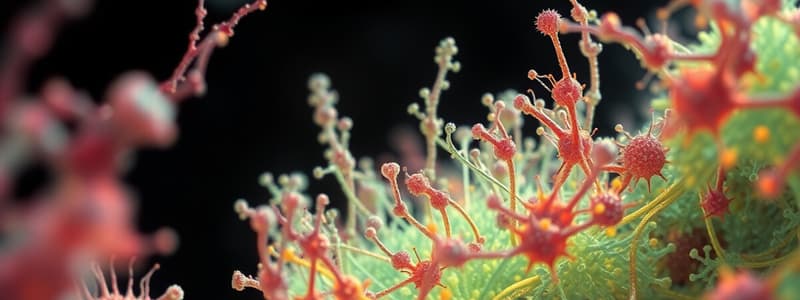Podcast
Questions and Answers
Which of the following characteristics differentiates a Transmission Electron Microscope (TEM) from a Scanning Electron Microscope (SEM)?
Which of the following characteristics differentiates a Transmission Electron Microscope (TEM) from a Scanning Electron Microscope (SEM)?
- TEM requires specimen sectioning and staining, whereas SEM does not. (correct)
- TEM utilizes light waves, whereas SEM uses electron beams.
- TEM scans the surface of an object, whereas SEM penetrates the object.
- TEM provides three-dimensional images, whereas SEM provides two-dimensional images.
An archaeologist discovers a preserved insect and needs to examine its surface structures in high detail. Which type of microscopy would be most suitable?
An archaeologist discovers a preserved insect and needs to examine its surface structures in high detail. Which type of microscopy would be most suitable?
- Scanning Electron Microscopy (SEM) (correct)
- Light Microscopy
- Transmission Electron Microscopy (TEM)
- Fluorescence Microscopy
A researcher is studying the internal structure of a virus. Which microscopy technique would be most appropriate for visualizing these details?
A researcher is studying the internal structure of a virus. Which microscopy technique would be most appropriate for visualizing these details?
- Transmission Electron Microscopy (TEM) (correct)
- Dark-field Microscopy
- Scanning Electron Microscopy (SEM)
- Phase-contrast Microscopy
If a scientist aims to create a high-resolution, three-dimensional image of the exterior of a bacterial cell, which microscopy method should they employ?
If a scientist aims to create a high-resolution, three-dimensional image of the exterior of a bacterial cell, which microscopy method should they employ?
Which of the following describes a key limitation of Transmission Electron Microscopy (TEM) compared to Scanning Electron Microscopy (SEM)?
Which of the following describes a key limitation of Transmission Electron Microscopy (TEM) compared to Scanning Electron Microscopy (SEM)?
Flashcards
Electron Microscopes
Electron Microscopes
Microscopes using electrons as an energy source for high magnification.
TEM (Transmission Electron Microscope)
TEM (Transmission Electron Microscope)
Electron microscope where electron beams pass through a specimen creating 2D images, useful for internal details.
TEM Specimen Preparation
TEM Specimen Preparation
Involves specific steps to prepare specimens for TEM, like cutting into thin slices and adding contrast.
SEM (Scanning Electron Microscope)
SEM (Scanning Electron Microscope)
Signup and view all the flashcards
SEM: No Sectioning
SEM: No Sectioning
Signup and view all the flashcards
Study Notes
- Electron microscopes utilize electrons as their energy source.
Transmission Electron Microscope (TEM)
- Electron beams pass through the specimen.
- Requires special preparation involving sectioning and staining.
- Produces two-dimensional images.
- Provides good internal detail of specimens.
Scanning Electron Microscope (SEM)
- Does not require sectioning of the specimen.
- Scans the surface of an object.
- Creates a three-dimensional image.
- An example is the Scanning Electron Micrograph of Campylobacter.
Studying That Suits You
Use AI to generate personalized quizzes and flashcards to suit your learning preferences.




